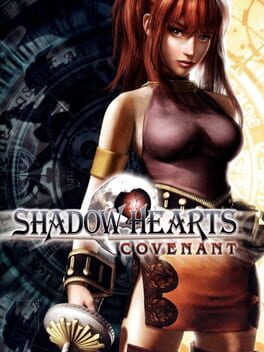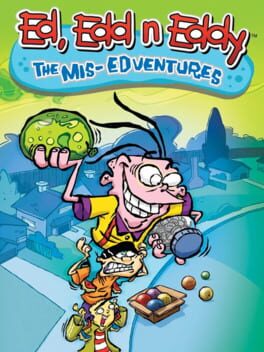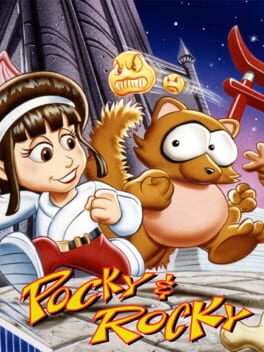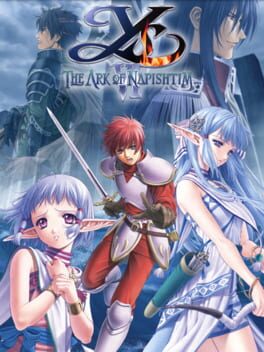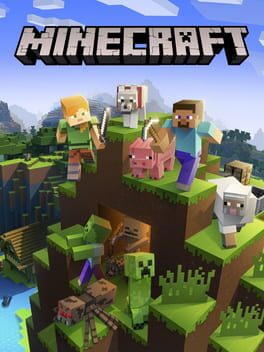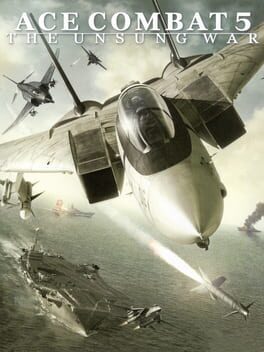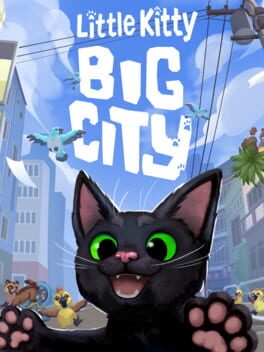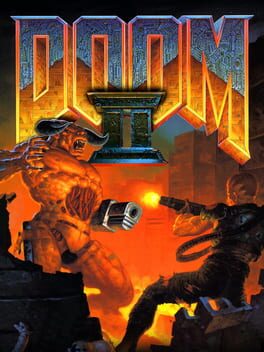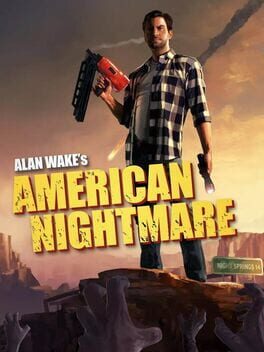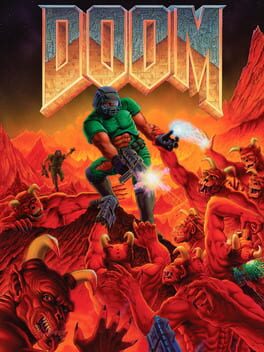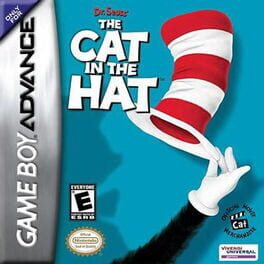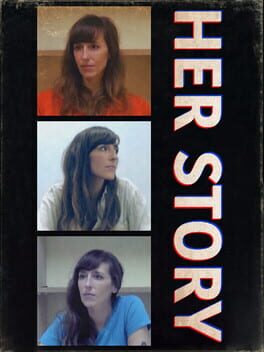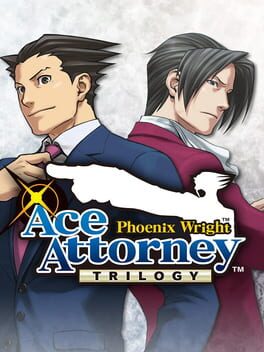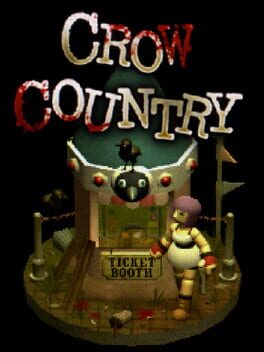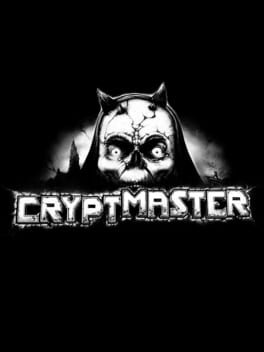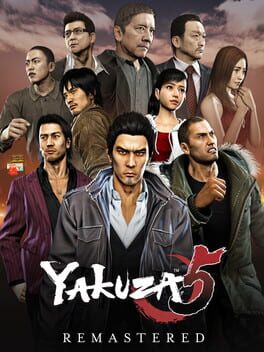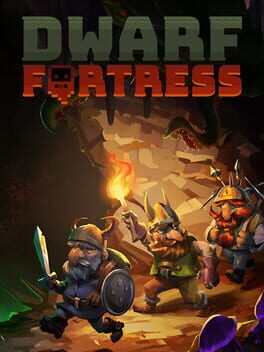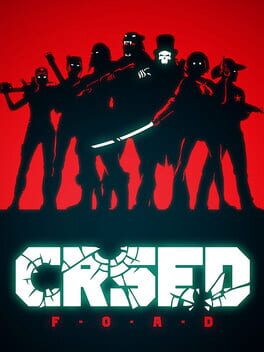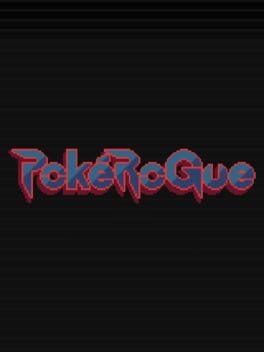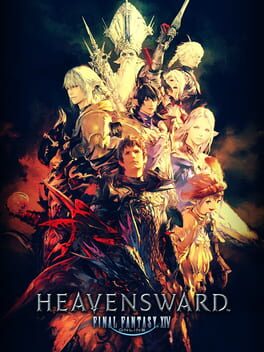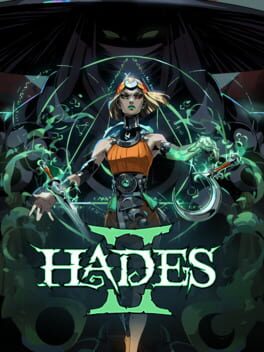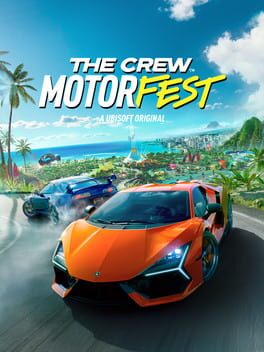They weren't lying, that niche PS2 JRPG a grand total of 30 people have heard of got hands. Has THE most comical jump in quality for a sequel I've ever seen, borderline perfect, my only minor issues would be a slow start and the game getting painfully easy once you get the hang of it but the battle system is one of the most unique things I've experienced in turn-based gaming so its fun in the end regardless. Also the music FUCKS.
Quite possibly the funniest game ever made (compliment)
Quite possibly the funniest game ever made (compliment)
Ed, Edd n Eddy: The Mis-Edventures captures the humor and art style of the cartoon well, offering a variety of levels and playable characters. However, the gameplay can feel sluggish and overly simplistic, leaving experienced players wanting more of a challenge. The short length may also disappoint those looking for a lengthy adventure.
Maravilha da natsume, pena que eu não gostei tanto
Assim, eu gostei muito de Wild Guns e como o jogo é da mesma empresa eu até pensei que gostaria também da mesma forma, e na real não foi assim que rolou..
Toda gameplay de Pocky and Rocky é MUITO BOA sem caô tu se diverte o tempo inteiro, as cores também são de uma qualidade absurda e eu até cheguei a me perguntar se o jogo era mesmo de SNES, o gráfico é muito bom e tudo nele é coisa de outro mundo se for levar em conta o ano lançado.
Só que o que me pegou foi o tamanho das fases e a dificuldade entre elas, achei longa demais e muito desequilibradas, tem picos muito alto de dificuldade do nada que desanimam bastante, se tornando um jogo bem punitivo.
Se não fosse por isso, o jogo ganharia fácil 5 estrelas, mas essas parada ai me decepcionou muito. Bom, pelo menos o carisma de cada personagem e da forma que a historinha é contada me deu vontade de continuar jogando.
Recomendo!
Assim, eu gostei muito de Wild Guns e como o jogo é da mesma empresa eu até pensei que gostaria também da mesma forma, e na real não foi assim que rolou..
Toda gameplay de Pocky and Rocky é MUITO BOA sem caô tu se diverte o tempo inteiro, as cores também são de uma qualidade absurda e eu até cheguei a me perguntar se o jogo era mesmo de SNES, o gráfico é muito bom e tudo nele é coisa de outro mundo se for levar em conta o ano lançado.
Só que o que me pegou foi o tamanho das fases e a dificuldade entre elas, achei longa demais e muito desequilibradas, tem picos muito alto de dificuldade do nada que desanimam bastante, se tornando um jogo bem punitivo.
Se não fosse por isso, o jogo ganharia fácil 5 estrelas, mas essas parada ai me decepcionou muito. Bom, pelo menos o carisma de cada personagem e da forma que a historinha é contada me deu vontade de continuar jogando.
Recomendo!
There was no guarantee that it would turn out like this. After the one-two punch of the first two Ys games in 1987 and 1988, the series would take a number of perplexing turns through the late 80s and early 90s. Ys III, originally intended as a gaiden, was a side-scrolling platformer with only the barest hints of RPG elements. Then the two primary creative forces behind the first three Ys games, Tomoyoshi Miyazaki and Masaya Hashimoto, left to found Quintet before a proper sequel could be developed. Unable to deliver a full game on its own, Nihon Falcom provided a scenario and music for two versions of Ys IV, both released in 1993: Tonkin House’s abysmal Mask of the Sun for Super Famicom, and Hudon’s Dawn of Ys for PC Engine CD-ROM², a highly-polished follow-up to the superlative PC Engine CD-ROM² ports of the first two games. Both versions of Ys IV strive to recreate the gameplay and style of the first two Ys games, but neither has a clue about how to evolve Ys beyond the basic bump combat that was growing stale by 1993.
The real death blow to the series, though, was 1995’s Ys V: Lost Kefin, Kingdom of Sand, a late Super Famicom release developed by Falcom that makes the first real stab at defining the future of the series. Ditching bump combat in favor of dedicated attack and jump buttons, Ys V plays a lot like a Quintet game, except it lacks the elegant construction and polish of games such as Illusion of Gaia and Terranigma. While it's a memorable adventure with many of Falcom’s classic touches (the soundtrack whips), it’s clearly rushed. The difficulty is wildly uneven, the attempts at platforming fall flat, and technical issues such as loading times reveal Falcom’s lack of expertise working with the Super Famicom hardware. It’s not a bad action-RPG, but it’s not Ys.
The only signs of Ys’s continued survival as a series for the rest of the 90s were well-received remakes of Ys I and II. This is where the story could have ended. Ys could have gone the way of Hydlide or any number of the other influential Japanese role-playing series that couldn’t keep up with the times. Even Falcom itself, by this point reduced to subsisting primarily on low-budget Windows games, seemed headed for a similar fate as its 80s Japanese microcomputer contemporaries. But instead we got Ys VI, the beginning of a remarkable second life not just for Ys but for Falcom as a whole.
After being sucked into the Great Vortex, a thinly veiled version of the Bermuda Triangle, Adol finds himself on the Canaan Islands, a thinly veiled pastiche of a Caribbean island chain dominated by the tension between its native peoples (the Rehda) and largely European colonizers (the Eresians). While the overarching story itself is no great shakes, Falcom’s gift for applying the sweeping grandeur of mythological fantasy bullshit to small-scale settings shines through.
There are only two small towns and a handful of other NPCs, but every character has a name, a character portrait, a personality, and even their own ongoing arcs. The little dramas that play out, from the town drunk turning a new leaf to the two siblings running rival shops, lend the game its heart. Perhaps the strongest of these threads is how the Eresians, largely trapped on the islands by the Great Vortex against their will, have learned to live on the islands. Some have embraced their fate, while others are haunted by it.
Doubling down on Ys V’s more traditional action-RPG mechanics, Ys VI’s combat is built around attack and jump buttons along with a very basic magic system. While it adds some new twists such as leveling up your three elemental swords, it’s surprisingly close to a highly refined version of Ys V’s combat. Unlike Ys V though, Ys VI’s combat is blazingly fast and fluid. It’s closer to a beat ’em up than the stiff action-RPGs of the 16-bit era, with Adol bouncing around against hordes of enemies who occasionally bombard him with danmaku-esque projectile patterns. On normal difficulty, the curve is just right, encouraging a mix of grinding and dexterity, but never rising to frustration.
While there are only a handful of dungeons, they’re all intricate mazes that are deeply satisfying to explore, although nothing here matches the scope and ambition of Darm Tower or Solomon Shrine. The game is on the short side, but highly replayable, with multiple difficulty levels and an optional Catastrophe mode that removes healing items. As with the best of the earlier Ys games, it’s closer to a Metroidvania than a traditional RPG. There’s no overworld, and the two islands that comprise the vast majority of the game can be traversed end-to-end in just a few minutes.
Despite its many highs, Ys VI stumbles in a few places. Pacing is uneven, with an extended exposition drop at the end of the second act in particular killing the momentum for no real payoff. Platforming is unnecessarily fussy, with a counterintuitive long jump mechanic that’s sure to annoy. These flaws pull the game down from all-timer status, but this is still a must-play for fans of Ys and Falcom. A number of key players in the company’s ongoing renaissance, including future president Toshihiro Kondo, worked on the game, and it’s a joy to see them begin to figure out the future Falcom style here. That isn’t even getting into the superb artwork or the spectacular soundtrack, which blends the style of classic Ys music, Ryo Yonemitsu’s beloved Redbook audio arrangements from the PC Engine CD-ROM² games, and modern touches such as drum’n’bass breaks. I already can’t wait to pick this one up again for a Nightmare mode run.
The real death blow to the series, though, was 1995’s Ys V: Lost Kefin, Kingdom of Sand, a late Super Famicom release developed by Falcom that makes the first real stab at defining the future of the series. Ditching bump combat in favor of dedicated attack and jump buttons, Ys V plays a lot like a Quintet game, except it lacks the elegant construction and polish of games such as Illusion of Gaia and Terranigma. While it's a memorable adventure with many of Falcom’s classic touches (the soundtrack whips), it’s clearly rushed. The difficulty is wildly uneven, the attempts at platforming fall flat, and technical issues such as loading times reveal Falcom’s lack of expertise working with the Super Famicom hardware. It’s not a bad action-RPG, but it’s not Ys.
The only signs of Ys’s continued survival as a series for the rest of the 90s were well-received remakes of Ys I and II. This is where the story could have ended. Ys could have gone the way of Hydlide or any number of the other influential Japanese role-playing series that couldn’t keep up with the times. Even Falcom itself, by this point reduced to subsisting primarily on low-budget Windows games, seemed headed for a similar fate as its 80s Japanese microcomputer contemporaries. But instead we got Ys VI, the beginning of a remarkable second life not just for Ys but for Falcom as a whole.
After being sucked into the Great Vortex, a thinly veiled version of the Bermuda Triangle, Adol finds himself on the Canaan Islands, a thinly veiled pastiche of a Caribbean island chain dominated by the tension between its native peoples (the Rehda) and largely European colonizers (the Eresians). While the overarching story itself is no great shakes, Falcom’s gift for applying the sweeping grandeur of mythological fantasy bullshit to small-scale settings shines through.
There are only two small towns and a handful of other NPCs, but every character has a name, a character portrait, a personality, and even their own ongoing arcs. The little dramas that play out, from the town drunk turning a new leaf to the two siblings running rival shops, lend the game its heart. Perhaps the strongest of these threads is how the Eresians, largely trapped on the islands by the Great Vortex against their will, have learned to live on the islands. Some have embraced their fate, while others are haunted by it.
Doubling down on Ys V’s more traditional action-RPG mechanics, Ys VI’s combat is built around attack and jump buttons along with a very basic magic system. While it adds some new twists such as leveling up your three elemental swords, it’s surprisingly close to a highly refined version of Ys V’s combat. Unlike Ys V though, Ys VI’s combat is blazingly fast and fluid. It’s closer to a beat ’em up than the stiff action-RPGs of the 16-bit era, with Adol bouncing around against hordes of enemies who occasionally bombard him with danmaku-esque projectile patterns. On normal difficulty, the curve is just right, encouraging a mix of grinding and dexterity, but never rising to frustration.
While there are only a handful of dungeons, they’re all intricate mazes that are deeply satisfying to explore, although nothing here matches the scope and ambition of Darm Tower or Solomon Shrine. The game is on the short side, but highly replayable, with multiple difficulty levels and an optional Catastrophe mode that removes healing items. As with the best of the earlier Ys games, it’s closer to a Metroidvania than a traditional RPG. There’s no overworld, and the two islands that comprise the vast majority of the game can be traversed end-to-end in just a few minutes.
Despite its many highs, Ys VI stumbles in a few places. Pacing is uneven, with an extended exposition drop at the end of the second act in particular killing the momentum for no real payoff. Platforming is unnecessarily fussy, with a counterintuitive long jump mechanic that’s sure to annoy. These flaws pull the game down from all-timer status, but this is still a must-play for fans of Ys and Falcom. A number of key players in the company’s ongoing renaissance, including future president Toshihiro Kondo, worked on the game, and it’s a joy to see them begin to figure out the future Falcom style here. That isn’t even getting into the superb artwork or the spectacular soundtrack, which blends the style of classic Ys music, Ryo Yonemitsu’s beloved Redbook audio arrangements from the PC Engine CD-ROM² games, and modern touches such as drum’n’bass breaks. I already can’t wait to pick this one up again for a Nightmare mode run.
From the cover alone, you can probably already tell what you're in for with Little Kitty, Big City, and yes, it is exactly as charming, delightful, and obnoxiously cute as you want it to be.
That said, as ridiculous as it sounds, I did have some slight apprehension going into this, given what kind of game Stray was (or, in this case, was not).
Thankfully, underneath all the sweetness, there is a fun lil platformer to be found in Little Kitty, Big City and it's not merely a cute cat simulator where you run around doing cute cat things. I mean, it is very much that as well, but it's also a half-decent collectathon with some simple but engaging puzzles and side quests for the titular little kitty to embark upon.
Really, 'simple but engaging' is perhaps the best way to describe this game. It doesn't try to be anything more or less than it needs to be. The entire thing can be finished in less than 6 hours, and outside of some wonky catforming controls and animations, it holds your attention the entire way through.
With fun platforming, endlessly delightful little touches to the cat's behaviour and animations throughout, an upbeat, jazzy score and a delightful sense of humour, it's exactly the kind of game you need to take a break from the 50+ hour narrative-heavy, live-service AAA games that inhabit the space.
Sometimes you just want to reject modernity and embrace kitty.
7.5/10
That said, as ridiculous as it sounds, I did have some slight apprehension going into this, given what kind of game Stray was (or, in this case, was not).
Thankfully, underneath all the sweetness, there is a fun lil platformer to be found in Little Kitty, Big City and it's not merely a cute cat simulator where you run around doing cute cat things. I mean, it is very much that as well, but it's also a half-decent collectathon with some simple but engaging puzzles and side quests for the titular little kitty to embark upon.
Really, 'simple but engaging' is perhaps the best way to describe this game. It doesn't try to be anything more or less than it needs to be. The entire thing can be finished in less than 6 hours, and outside of some wonky catforming controls and animations, it holds your attention the entire way through.
With fun platforming, endlessly delightful little touches to the cat's behaviour and animations throughout, an upbeat, jazzy score and a delightful sense of humour, it's exactly the kind of game you need to take a break from the 50+ hour narrative-heavy, live-service AAA games that inhabit the space.
Sometimes you just want to reject modernity and embrace kitty.
7.5/10
Doom II on the Game Boy Advance is a surprisingly good port of the classic shooter. While the graphics are understandably scaled back, the core gameplay remains intact, offering fast-paced demon slaying action. The controls are serviceable, though aiming can be a bit tricky. It's a great way to experience this classic on the go, though newcomers might find it a bit dated.
Honestly? I like it. Shame it's a very short game.
The concepts of how much Alan loathes his darker part are pretty good and having the Dark Place take physical manifestation of him is pretty good.While also grasping the stuck in purgatory hell syndrome, which is somewhat relatable (Twin Peaks wink wink wonk wonk in the corner) I know it's you BOB xD
Also man Scratch is the perfect kind of guy that you hate but also like due to his shenanigans. (He ain't laying a finger on Barry or Alice or so god help me)
The concepts of how much Alan loathes his darker part are pretty good and having the Dark Place take physical manifestation of him is pretty good.
Also man Scratch is the perfect kind of guy that you hate but also like due to his shenanigans. (He ain't laying a finger on Barry or Alice or so god help me)
Doom on the Game Boy Advance is a surprisingly good port of the classic FPS, managing to retain much of the feel and atmosphere of the original despite the hardware limitations. While the visuals are understandably downgraded and the controls take some getting used to, the core gameplay of blasting demons remains satisfying. It's a testament to the strength of the source material that it still holds up on such a small screen. The addition of exclusive multiplayer maps is a nice touch for those who can wrangle up friends with GBAs.
Dr. Seuss' The Cat in the Hat for Game Boy Advance fails to capture the whimsical charm of the beloved children's book. The gameplay is repetitive and uninspired, consisting mostly of basic platforming and unimaginative combat. While the graphics are colorful and true to the source material, the sound design is grating and quickly becomes annoying. Overall, this game is a missed opportunity to create a fun and engaging experience for fans of the Cat in the Hat.
This review contains spoilers
[There will be spoilers for the original game as well as both current entries in the Remake continuity as a heads up!]
The original Final Fantasy VII is about many things, but I would say its most enduring theme is processing loss--being able to say goodbye, persevering in spite of that loss, knowing that those we love can live forever through the legacy they've left behind. So here we are, with the middle chapter of the Remake Continuity, which would ostensibly include that pivotal thematic moment, and its impact on me as a sequel is less about continuing the original story [or even branching off into its own retelling] and more a follow-up to my review for Final Fantasy XVI, an admittedly pretty goofy but sincere eulogy for my love for Final Fantasy as a franchise moving forward. Now I feel I can actually say goodbye, and it's because in an unfathomable number of ways Final Fantasy VII Rebirth is incapable of the same.
When you leave Midgar in the original FF7, the bounds previously placed on your understanding of the physical world expand into, as far as you're concerned, the infinite. Midgar is enormous, and its enormity amounts to a gross blemish on a much larger planet the second you escape its walls. Similarly, when you leave Midgar at the conclusion of Final Fantasy VII Remake, the exciting thing is the increasing size of the story's possibility space. It doesn't necessarily land its telling, but Remake ends with you severing the threads of fate. Now anything can happen--Aerith even says as much, and that character delivering that story beat provides some obvious [and frankly emotionally manipulative] implications.
I was okay with this. I love Final Fantasy VII, but I am not married to it being faithfully recreated [as much as I would probably actually enjoy that], even when it comes to the fate of Aerith, one of the most widely familiar Video Game Story Moments. Obviously the original Final Fantasy VII does not work if Aerith does not die. But that's why the Remake trilogy could have been something exciting--the story wouldn't necessarily have to rely on it. It could thematically pivot--maybe someone else dies as a reminder that fate is still outside of your grasp, maybe Aerith still dies because fate is never truly conquered. I don't know, I'm not a terribly capable writer and I certainly can't craft stories, and thankfully there are people in the world who will do that for me.
What I do know is that I strongly appreciate stories told with conviction and stories with actual emotional weight, and after finishing Rebirth I'm not convinced that the writers know how to do either. Sometimes character performances power through and connect, but so many important emotional moments are undercut immediately by overexcited, childlike bursts of "ideas."
There were several moments of doubt before, but the sequence with Dyne and Barret--friends years ago, separated by their ideologies and tragically set on different paths in life--sent deafening sirens. In the original, following an intense encounter but before falling down a cliff to his death, a physically and emotionally broken Dyne makes Barret promise to never make Marlene cry--Dyne's biological daughter whom Barret has adopted under the assumption Dyne died years in the past. In Rebirth, after a fight in which he becomes fucking Magneto [what?], Dyne instead tells Barret to live with his guilt [incredibly dark, and an interesting alteration] before dying--not by falling to his death, mind you, because mirroring the events of the flashback sequence in which Barret let go of Dyne's arm and watched him fall and presumably die was I guess too much for the storytelling, but instead by being gunned down in a blaze of glory by Shinra soldiers [not an interesting alteration]. Then, before the player is allowed to dwell on his grim parting words, Shinra immediately sends in a huge frog robot piloted by Palmer, a side character who largely exists for comedic purposes, and the party is forced into a fight with it. Then the game gets back to Barret and Dyne for a moment [a minor and genuinely satisfying moment in which Cloud shows support for Barret] before the party is forced into a bad vehicular shooting minigame on rails. Consider me moved!
Final Fantasy VII is a rollercoaster of vibes and frequently jumps between melancholy and humor, but it also knew when to let moments just exist. After concluding the sequence with Dyne in Rebirth, I had no faith that Aerith's destiny would be portrayed in a satisfying manner--after all, the implications of her fate are far more complex, with much heavier player investment, and tied to expectations of where this narrative might diverge on top of all that. Meanwhile, Dyne's story is a fastbreak open layup of an emotional payoff that the game somehow managed to botch despite recognizing some of the details, simply because it can't help itself and needs to keep adding things.
Final Fantasy VII Rebirth is a game about being More, at the expense of the journey's details at every possible turn. Nowhere is this more evident than in the open world activities of the game, which feel partially necessary if you're interested in improving gear or obtaining a lot of materia types to play with, but are so laborious and dreary that after completing the first area I simply... stopped doing them, outside of anything that was on the way to my objectives [since every activity you do serves as a fast travel spot, which feels like a concession that getting around is eventually just annoying]. I would identify the most interesting sounding materia available from Chadley in each region, keep a mental note of roughly how many points I would need to get at least one of each, and do the quickest activities with least resistance in order to get the required points. But then the game kept adding regions, even turning Gongaga into an incomprehensible mushroom jungle, and so I just stopped engaging with the side content pretty much entirely, even refusing to talk to Chadley. [Which, honestly, fantastic.]
And what are the activities? Some roughly mirror normal activities in the game [combat activities as well as towers which almost always have a combat encounter at their base], but others are braindead. At one, you press triangle three times and look at pretty scenery. At another, you repeat a sequence of button presses. At another, you awkwardly stumble around on a chocobo and hold up on the D-pad so it can sniff out item locations very slowly. I eventually identified which ones were potentially the most helpful and tried to stick to those, though unfortunately the chocobo excavations were the most interesting to me as they led to crafting recipes for upgrading gear, and even more unfortunately you have to do the expeditions, the aforementioned "press triangle three times" activity, to unlock them.
In my meandering review of Final Fantasy XVI I mentioned how the bloat in that game existed, as far as I can tell, for the sole purpose of extending the experience for perceived value. The open world side of Final Fantasy VII Rebirth is very much like that kind of bloat, and even more hilariously resembles common big-budget game design [the towers are distinctly Ubisoft open world garbage]. What's absolutely puzzling about Rebirth, however, is that a lot of its other non-narrative bloat comes with good intentions. [Not pushing mako vacuums around though. What on earth.]
A lot of older Final Fantasy games thrived on relentless throwaway minigames that were charming through their frequency and brevity. I don't doubt that the creators of Rebirth love that particular aspect of Final Fantasy VII--all you have to do is look at the setup for the soldier routine sequence in Junon. Originally a set of simple quick minigames in which you pretended to be a Shinra grunt soldier and do militaristic routines for a parade, it's now been elaborated upon so that you track down and "recruit" ranks of soldiers of different formations and then "equip" them depending on your desired difficulty/reward for the eventual parade minigame [basically the Honeybee dance sequence from Remake, which, sidenote, is still the worst-presented QTE in terms of clarity I've maybe ever seen in a game, so I wasn't exactly thrilled that it was being reused]. Is this setup unique? Sure, I guess! But it's setup, and it is exhausting to be presented with a tutorial for the setup to a minigame when in the original it was something that took maybe a couple minutes.
Or look to the dolphin sequence, also in Junon. Originally a dolphin helps you reach the top of Junon by jumping you up onto a tower; you simply find the right position and hit a button, and it takes a minute but is immediately understandable. In Rebirth, you now run a race course with the dolphin, running into balls to increase your speed [???] in order to complete the track within a given time limit--all to accomplish the same exact thing. It requires tutorial explanation as well, it lasts maybe 2 minutes, and it's not very interesting. Cool!
There are countless other examples, some of which simply attempt to add fun moments for characters--though I refuse to even talk about the Shinra mansion "puzzle dungeon" with Cait Sith. But most of these were obviously made by people who love the original game. That's what's so utterly maddening. Why in God's name would you go through the effort of creating a specific racing minigame with unique mechanics to elaborate on a small throwaway moment if you didn't? It's a game that serves as a tribute to the lovable, zany qualities of the series, but doesn't recognize that it's embracing its inspiration so tightly that it's suffocating it.
Which brings me back to Aerith, and the most egregious failure of the story. So Remake ends with a vision of a surviving Zack Fair as an indication that nothing is guaranteed anymore and that fate has changed. What Square coyly neglected to elaborate on with Remake is that it's not necessarily that the world has changed, but instead that there are many worlds. You know, parallel universes, probably one of the worst and most difficult storytelling devices for emotional payoff? So the possibilities are endless not in the way that a player familiar with Final Fantasy VII should be on edge with excitement as they can no longer predict the central narrative of a story they cherish, but instead in a way that stakes are hard to establish anymore. So when Aerith is "still" killed at the conclusion of Rebirth, she is also not killed, because she exists in parallel worlds, kind of? It's having it both ways, and the verb "dulls" doesn't properly communicate the damage that does to processing Aerith's character emotionally.
When you feel Aerith's presence for the remainder of Final Fantasy VII, it's with a great deal of sadness because she is still gone. The end of Rebirth implies all the characters will continue to feel her presence as well, but since we're likely still going to see her throughout the final game--whether it's through some Marvel Cinematic Universe-esque horseshit or simply through Cloud's imagination--we won't be able to say goodbye in the same way. And no amount of pretty good combat mechanics [as satisfying as most of the characters are to control, and as confident as Square is getting with this battle system] or strong voiceover performances from the main cast [the actual saving grace of Rebirth] will make that better.
The original Final Fantasy VII is about many things, but I would say its most enduring theme is processing loss--being able to say goodbye, persevering in spite of that loss, knowing that those we love can live forever through the legacy they've left behind. So here we are, with the middle chapter of the Remake Continuity, which would ostensibly include that pivotal thematic moment, and its impact on me as a sequel is less about continuing the original story [or even branching off into its own retelling] and more a follow-up to my review for Final Fantasy XVI, an admittedly pretty goofy but sincere eulogy for my love for Final Fantasy as a franchise moving forward. Now I feel I can actually say goodbye, and it's because in an unfathomable number of ways Final Fantasy VII Rebirth is incapable of the same.
When you leave Midgar in the original FF7, the bounds previously placed on your understanding of the physical world expand into, as far as you're concerned, the infinite. Midgar is enormous, and its enormity amounts to a gross blemish on a much larger planet the second you escape its walls. Similarly, when you leave Midgar at the conclusion of Final Fantasy VII Remake, the exciting thing is the increasing size of the story's possibility space. It doesn't necessarily land its telling, but Remake ends with you severing the threads of fate. Now anything can happen--Aerith even says as much, and that character delivering that story beat provides some obvious [and frankly emotionally manipulative] implications.
I was okay with this. I love Final Fantasy VII, but I am not married to it being faithfully recreated [as much as I would probably actually enjoy that], even when it comes to the fate of Aerith, one of the most widely familiar Video Game Story Moments. Obviously the original Final Fantasy VII does not work if Aerith does not die. But that's why the Remake trilogy could have been something exciting--the story wouldn't necessarily have to rely on it. It could thematically pivot--maybe someone else dies as a reminder that fate is still outside of your grasp, maybe Aerith still dies because fate is never truly conquered. I don't know, I'm not a terribly capable writer and I certainly can't craft stories, and thankfully there are people in the world who will do that for me.
What I do know is that I strongly appreciate stories told with conviction and stories with actual emotional weight, and after finishing Rebirth I'm not convinced that the writers know how to do either. Sometimes character performances power through and connect, but so many important emotional moments are undercut immediately by overexcited, childlike bursts of "ideas."
There were several moments of doubt before, but the sequence with Dyne and Barret--friends years ago, separated by their ideologies and tragically set on different paths in life--sent deafening sirens. In the original, following an intense encounter but before falling down a cliff to his death, a physically and emotionally broken Dyne makes Barret promise to never make Marlene cry--Dyne's biological daughter whom Barret has adopted under the assumption Dyne died years in the past. In Rebirth, after a fight in which he becomes fucking Magneto [what?], Dyne instead tells Barret to live with his guilt [incredibly dark, and an interesting alteration] before dying--not by falling to his death, mind you, because mirroring the events of the flashback sequence in which Barret let go of Dyne's arm and watched him fall and presumably die was I guess too much for the storytelling, but instead by being gunned down in a blaze of glory by Shinra soldiers [not an interesting alteration]. Then, before the player is allowed to dwell on his grim parting words, Shinra immediately sends in a huge frog robot piloted by Palmer, a side character who largely exists for comedic purposes, and the party is forced into a fight with it. Then the game gets back to Barret and Dyne for a moment [a minor and genuinely satisfying moment in which Cloud shows support for Barret] before the party is forced into a bad vehicular shooting minigame on rails. Consider me moved!
Final Fantasy VII is a rollercoaster of vibes and frequently jumps between melancholy and humor, but it also knew when to let moments just exist. After concluding the sequence with Dyne in Rebirth, I had no faith that Aerith's destiny would be portrayed in a satisfying manner--after all, the implications of her fate are far more complex, with much heavier player investment, and tied to expectations of where this narrative might diverge on top of all that. Meanwhile, Dyne's story is a fastbreak open layup of an emotional payoff that the game somehow managed to botch despite recognizing some of the details, simply because it can't help itself and needs to keep adding things.
Final Fantasy VII Rebirth is a game about being More, at the expense of the journey's details at every possible turn. Nowhere is this more evident than in the open world activities of the game, which feel partially necessary if you're interested in improving gear or obtaining a lot of materia types to play with, but are so laborious and dreary that after completing the first area I simply... stopped doing them, outside of anything that was on the way to my objectives [since every activity you do serves as a fast travel spot, which feels like a concession that getting around is eventually just annoying]. I would identify the most interesting sounding materia available from Chadley in each region, keep a mental note of roughly how many points I would need to get at least one of each, and do the quickest activities with least resistance in order to get the required points. But then the game kept adding regions, even turning Gongaga into an incomprehensible mushroom jungle, and so I just stopped engaging with the side content pretty much entirely, even refusing to talk to Chadley. [Which, honestly, fantastic.]
And what are the activities? Some roughly mirror normal activities in the game [combat activities as well as towers which almost always have a combat encounter at their base], but others are braindead. At one, you press triangle three times and look at pretty scenery. At another, you repeat a sequence of button presses. At another, you awkwardly stumble around on a chocobo and hold up on the D-pad so it can sniff out item locations very slowly. I eventually identified which ones were potentially the most helpful and tried to stick to those, though unfortunately the chocobo excavations were the most interesting to me as they led to crafting recipes for upgrading gear, and even more unfortunately you have to do the expeditions, the aforementioned "press triangle three times" activity, to unlock them.
In my meandering review of Final Fantasy XVI I mentioned how the bloat in that game existed, as far as I can tell, for the sole purpose of extending the experience for perceived value. The open world side of Final Fantasy VII Rebirth is very much like that kind of bloat, and even more hilariously resembles common big-budget game design [the towers are distinctly Ubisoft open world garbage]. What's absolutely puzzling about Rebirth, however, is that a lot of its other non-narrative bloat comes with good intentions. [Not pushing mako vacuums around though. What on earth.]
A lot of older Final Fantasy games thrived on relentless throwaway minigames that were charming through their frequency and brevity. I don't doubt that the creators of Rebirth love that particular aspect of Final Fantasy VII--all you have to do is look at the setup for the soldier routine sequence in Junon. Originally a set of simple quick minigames in which you pretended to be a Shinra grunt soldier and do militaristic routines for a parade, it's now been elaborated upon so that you track down and "recruit" ranks of soldiers of different formations and then "equip" them depending on your desired difficulty/reward for the eventual parade minigame [basically the Honeybee dance sequence from Remake, which, sidenote, is still the worst-presented QTE in terms of clarity I've maybe ever seen in a game, so I wasn't exactly thrilled that it was being reused]. Is this setup unique? Sure, I guess! But it's setup, and it is exhausting to be presented with a tutorial for the setup to a minigame when in the original it was something that took maybe a couple minutes.
Or look to the dolphin sequence, also in Junon. Originally a dolphin helps you reach the top of Junon by jumping you up onto a tower; you simply find the right position and hit a button, and it takes a minute but is immediately understandable. In Rebirth, you now run a race course with the dolphin, running into balls to increase your speed [???] in order to complete the track within a given time limit--all to accomplish the same exact thing. It requires tutorial explanation as well, it lasts maybe 2 minutes, and it's not very interesting. Cool!
There are countless other examples, some of which simply attempt to add fun moments for characters--though I refuse to even talk about the Shinra mansion "puzzle dungeon" with Cait Sith. But most of these were obviously made by people who love the original game. That's what's so utterly maddening. Why in God's name would you go through the effort of creating a specific racing minigame with unique mechanics to elaborate on a small throwaway moment if you didn't? It's a game that serves as a tribute to the lovable, zany qualities of the series, but doesn't recognize that it's embracing its inspiration so tightly that it's suffocating it.
Which brings me back to Aerith, and the most egregious failure of the story. So Remake ends with a vision of a surviving Zack Fair as an indication that nothing is guaranteed anymore and that fate has changed. What Square coyly neglected to elaborate on with Remake is that it's not necessarily that the world has changed, but instead that there are many worlds. You know, parallel universes, probably one of the worst and most difficult storytelling devices for emotional payoff? So the possibilities are endless not in the way that a player familiar with Final Fantasy VII should be on edge with excitement as they can no longer predict the central narrative of a story they cherish, but instead in a way that stakes are hard to establish anymore. So when Aerith is "still" killed at the conclusion of Rebirth, she is also not killed, because she exists in parallel worlds, kind of? It's having it both ways, and the verb "dulls" doesn't properly communicate the damage that does to processing Aerith's character emotionally.
When you feel Aerith's presence for the remainder of Final Fantasy VII, it's with a great deal of sadness because she is still gone. The end of Rebirth implies all the characters will continue to feel her presence as well, but since we're likely still going to see her throughout the final game--whether it's through some Marvel Cinematic Universe-esque horseshit or simply through Cloud's imagination--we won't be able to say goodbye in the same way. And no amount of pretty good combat mechanics [as satisfying as most of the characters are to control, and as confident as Square is getting with this battle system] or strong voiceover performances from the main cast [the actual saving grace of Rebirth] will make that better.
This is in the same vein as Pseudoregelia for me, it was good for what it is, but nothing to go insane about. The item abilites were cool, I love using the bubble wand to break some moments. The game was perfectly balanced around what you can do. I will say there was stuff that annoyed me. The Ghost Dog was really annoying to deal with, the spikes would sometimes blend in well with the background that it would be hard to tell what's there and what wasn't, and for waht it is, the $25 asking price is a bit too much. Still fun, but nothing to freak out over or to get right away.
In 2023 I saw a bundle of this trilogy and The Great Ace Attorney Chronicles for crazy cheap on the eShop and thought those were a perfect fit to be played on the Switch. I had a hunch I’d enjoy these games, I’d always see memes and pics of its characters, but after playing the original trilogy, I didn’t really like it. No, I absolutely LOVED it!
[This review contains spoilers, so be sure to have played the games before reading!]
For a series that simply boils down to clicking on the screen and reading, it’s crazy just how riveting Ace Attorney is. I guess point and click appreciators and visual novel readers probably know how enrapturing games of those genres can be, but I had never played anything like that, so my experience with this series opened a brand new door for me.
What makes it so appealing are the characters and the narrative. The main cast is SO endearing and their dynamic is just a blast to see. Phoenix having to deal with Maya’s dumb remarks, Edgeworth being an absolute tsun, the Judge being the most malleable person in the world, Gumshoe being the most adorable AND trustworthy dork in the world (he’s THE BEST!!!)... I quickly got attached to all of them, and even to some recurring side characters and case-specific characters. There’s no shortage of personalities that will make you intrigued and get you laughing.
It’s because of all those characters that the cases become so gripping, along with the writing that rarely ever disappoints. The first game doesn’t get too crazy with the narrative, but starting from the second game they turn the supernatural elements up to eleven, with a huge focus on the mediums of the Fey Clan. The third game dives deep into the backstory of the main cast with its flashback cases, something that gives you an even greater appreciation for them and makes the finale incredibly gratifying.
Oh yeah, and the music! There are so many catchy tunes in these games, and their impact during the trial segments cannot be understated. As you’re cross-examining witnesses, a calm but intriguing theme plays, but as you get closer to uncovering their lies, the same tune gets faster and with more elements added to it, giving you an extra push to finish them once and for all. And nothing feels more empowering than presenting the right evidence, the music going completely silent, saying OBJECTION!!! and hearing the objection theme start. Same thing for when the pursuit theme starts as the culprit is about to break down. It’s an unrivaled rush of adrenaline and satisfaction.
If I were to rank each game individually, my order would be the first game, then Trials and Tribulations, then Justice for All. They’re all great, though! And yes, I’m aware 90% of Ace Attorney fans consider the third game to be the best in the whole series, which is totally deserved, given the strength of its cases, how they’re connected together and how nicely it wraps the trilogy up (and also the fact it has Godot, one of the best characters in the series), but my experience with the first one was truly special.
Of course, there’s the fact I was experiencing the thrill of trials and all the crazy plot twists of the narrative for the first time, which you start getting used to as you play the games, but the aspect that makes my time with the first game stand out is the fact I didn’t savescum. Every Ace Attorney veteran knows how it’s almost muscle memory to save right before an important decision, but I only found out about that strategy after I had finished the first game! So the trials were much more tense due to the fear of getting a game over, which did happen 3 or 4 times.
Something else that helps this game take the top spot is the fact it contains my favorite case out of all 3 games: Rise from the Ashes. I wasn’t prepared for how long this case would be - I started playing it early in the morning during a weekend and finished it by 1 AM, playing basically nonstop, because I was totally immersed in it! It has so many memorable elements to it, such as its cast of characters, from the quirky Ema to the smooth Marshall, and of course Damon Gant, my fav “villain” in the series so far; all the twists that kept surprising me constantly during its LONG trial sections, which you gotta remember I didn’t savescum; the slew of new mechanics it introduces, such as the forensics stuff and the video footage review... I kept thinking about this case for at least a month after finishing it.
There are several cases I would’ve loved to talk about, like the one you defend Edgeworth against the most despicable prosecutor in the world (and you expose him BY USING A METAL DETECTOR THAT WAS SITTING ON YOUR EVIDENCES AND YOU THOUGHT WAS WORTHLESS AND IT’S SO SATISFYING), or the one you gotta cross-examine a serial killer who’s talking through a walkie-talkie, or the one with a Phoenix impersonator who actually looks nothing like him, or the one where the defendant fucking kills himself by poisoning and drops dead on the stand... but then we’d be here all day.
I got into many new game series in 2023, such as Pikmin and Yakuza, but Ace Attorney is certainly one of the franchises I’m most grateful for getting into. I still didn't get around to play The Great Ace Attorney Chronicles and the new Apollo Justice Trilogy, but I'll definitely do so in the near future.
[This review contains spoilers, so be sure to have played the games before reading!]
For a series that simply boils down to clicking on the screen and reading, it’s crazy just how riveting Ace Attorney is. I guess point and click appreciators and visual novel readers probably know how enrapturing games of those genres can be, but I had never played anything like that, so my experience with this series opened a brand new door for me.
What makes it so appealing are the characters and the narrative. The main cast is SO endearing and their dynamic is just a blast to see. Phoenix having to deal with Maya’s dumb remarks, Edgeworth being an absolute tsun, the Judge being the most malleable person in the world, Gumshoe being the most adorable AND trustworthy dork in the world (he’s THE BEST!!!)... I quickly got attached to all of them, and even to some recurring side characters and case-specific characters. There’s no shortage of personalities that will make you intrigued and get you laughing.
It’s because of all those characters that the cases become so gripping, along with the writing that rarely ever disappoints. The first game doesn’t get too crazy with the narrative, but starting from the second game they turn the supernatural elements up to eleven, with a huge focus on the mediums of the Fey Clan. The third game dives deep into the backstory of the main cast with its flashback cases, something that gives you an even greater appreciation for them and makes the finale incredibly gratifying.
Oh yeah, and the music! There are so many catchy tunes in these games, and their impact during the trial segments cannot be understated. As you’re cross-examining witnesses, a calm but intriguing theme plays, but as you get closer to uncovering their lies, the same tune gets faster and with more elements added to it, giving you an extra push to finish them once and for all. And nothing feels more empowering than presenting the right evidence, the music going completely silent, saying OBJECTION!!! and hearing the objection theme start. Same thing for when the pursuit theme starts as the culprit is about to break down. It’s an unrivaled rush of adrenaline and satisfaction.
If I were to rank each game individually, my order would be the first game, then Trials and Tribulations, then Justice for All. They’re all great, though! And yes, I’m aware 90% of Ace Attorney fans consider the third game to be the best in the whole series, which is totally deserved, given the strength of its cases, how they’re connected together and how nicely it wraps the trilogy up (and also the fact it has Godot, one of the best characters in the series), but my experience with the first one was truly special.
Of course, there’s the fact I was experiencing the thrill of trials and all the crazy plot twists of the narrative for the first time, which you start getting used to as you play the games, but the aspect that makes my time with the first game stand out is the fact I didn’t savescum. Every Ace Attorney veteran knows how it’s almost muscle memory to save right before an important decision, but I only found out about that strategy after I had finished the first game! So the trials were much more tense due to the fear of getting a game over, which did happen 3 or 4 times.
Something else that helps this game take the top spot is the fact it contains my favorite case out of all 3 games: Rise from the Ashes. I wasn’t prepared for how long this case would be - I started playing it early in the morning during a weekend and finished it by 1 AM, playing basically nonstop, because I was totally immersed in it! It has so many memorable elements to it, such as its cast of characters, from the quirky Ema to the smooth Marshall, and of course Damon Gant, my fav “villain” in the series so far; all the twists that kept surprising me constantly during its LONG trial sections, which you gotta remember I didn’t savescum; the slew of new mechanics it introduces, such as the forensics stuff and the video footage review... I kept thinking about this case for at least a month after finishing it.
There are several cases I would’ve loved to talk about, like the one you defend Edgeworth against the most despicable prosecutor in the world (and you expose him BY USING A METAL DETECTOR THAT WAS SITTING ON YOUR EVIDENCES AND YOU THOUGHT WAS WORTHLESS AND IT’S SO SATISFYING), or the one you gotta cross-examine a serial killer who’s talking through a walkie-talkie, or the one with a Phoenix impersonator who actually looks nothing like him, or the one where the defendant fucking kills himself by poisoning and drops dead on the stand... but then we’d be here all day.
I got into many new game series in 2023, such as Pikmin and Yakuza, but Ace Attorney is certainly one of the franchises I’m most grateful for getting into. I still didn't get around to play The Great Ace Attorney Chronicles and the new Apollo Justice Trilogy, but I'll definitely do so in the near future.
I played the demo for this game and was blown away. It seemed like a fun take on a typing game, but when I got the full game the ideas presented to me in the demo just got vary arduous soon after the demo ended.
Cryptmaster is a dungeon crawler mixed with text adventure, with a typing game also. There are many puzzles and dialogue things where you can just type whatever you want, so things are very "open ended"(?) kind of? This could be cool, the allure of text adventure games is the freedom you could have from being able to "do anything", but that is the same allure that falls short in this game.
There are a lot of mechanics that feed into each other so I kind of just have to start explaining them all. Let's start with the memories of your 4 person party. At all times your party will have a blank word that will gradually fill up as you gain letters. Letters are gained from fighting enemies, doing riddles, or opening chests. The more letters you have, the easier you can guess the word, but you can type in the word anything once its the one on screen. These memories can either be lore, or moves to use in combat. There appears to be like 40-ish for each person, mostly consisting of lore from what I could tell. I beat the game and ended up with like less than 20 on each character.
Chests are puzzles in which you ask the Cryptmaster to describe a mystery item (look, touch, remember what it did, taste, etc.). Limited number of guesses, and when you solve it all the letters get put into your memory words. There are skulls that give you riddles to figure out, and similarly if you solve them, the letters get added. The problem with these is purely a chance thing where maybe none of the letters actually help you, or you already had those letters, just fucking annoying i think.
Fighting enemies gives you 1 letter of your choosing from their name, but I find the combat fucking annoying. The combat is recommenced to be in real time (more in line with most typing games), or you can do a version of turn based combat. In real time, you must type your moves fast while a timer counts when the enemy will attack. However, you have a cooldown after each move (per character), and this feels so ridiculously long compared to enemy attack speed. Also the fact you have to remember every move for 4 characters in a high speed fight, that was just not feasible for me, so I went to turn based. Turn based isn't traditional turnbased, it just makes every letter typed advance time. Enemy attack timer goes down per letter, and when a party member is on cooldown, each letter takes away a segment of cooldown. This slows it down so you can think and you can actually look at your list of attacks, providing more "strategy". Turn based was a band-aid to finish the game because I don't think the combat is good overall. I will say its mainly because the moves all kind of suck too. idk none of them felt really good to use, but maybe there are cooler moves i didnt unlock even though i beat the game! Maybe if I could get memory words faster, combat would be better, but even then combat just woudlnt be fun until "late game" so it seems not very good.
Then the other part of this game besides combat is the mystery object and riddles and boy FUCK do I hate word puzzles. I didn't think this game would be so full of them, so fuck me i guess. Im just not good at them. I can't solve riddles, and I cant remember words when I need to. Then it just pisses me off like really bad man. If you like word puzzles you might be happier than I!
Also, there is a card game in this, and I also think it sucks. Maybe thats just me not understanding how I should play it, or not understanding how to build a deck, but you dont get a lot of cards to even build one. Most cards you get from beating opponents, but you have to beat them with your crap cards.
The card game has you draw 4 cards, and a whole row of random letters (maybe like 20ish?). You pick 2 letters at a time, and if any of the letters are in the name of the cards in your hand, you deal damage. If you get all the letters in a card's name, its effect will happen. You can also skip your turn to mulligan your letters. This is heavily reliant on you actually getting letters you can fucking use in your hand, which I barely ever had. From what I could piece is that deckbuilding would revolve around either picking cards with a variety of letters so you can have more letters that are useful, or cards with a small variety so letters do more damage per pick. Again, you don't really get a lot of cards to do either of these I feel. Maybe I just fundamentally did not understand this card game, but I dont think its very fun at all.
Mainly just every mechanic frustrated me and it just did not gel with me, im sad it didnt, but oh well.
Cryptmaster is a dungeon crawler mixed with text adventure, with a typing game also. There are many puzzles and dialogue things where you can just type whatever you want, so things are very "open ended"(?) kind of? This could be cool, the allure of text adventure games is the freedom you could have from being able to "do anything", but that is the same allure that falls short in this game.
There are a lot of mechanics that feed into each other so I kind of just have to start explaining them all. Let's start with the memories of your 4 person party. At all times your party will have a blank word that will gradually fill up as you gain letters. Letters are gained from fighting enemies, doing riddles, or opening chests. The more letters you have, the easier you can guess the word, but you can type in the word anything once its the one on screen. These memories can either be lore, or moves to use in combat. There appears to be like 40-ish for each person, mostly consisting of lore from what I could tell. I beat the game and ended up with like less than 20 on each character.
Chests are puzzles in which you ask the Cryptmaster to describe a mystery item (look, touch, remember what it did, taste, etc.). Limited number of guesses, and when you solve it all the letters get put into your memory words. There are skulls that give you riddles to figure out, and similarly if you solve them, the letters get added. The problem with these is purely a chance thing where maybe none of the letters actually help you, or you already had those letters, just fucking annoying i think.
Fighting enemies gives you 1 letter of your choosing from their name, but I find the combat fucking annoying. The combat is recommenced to be in real time (more in line with most typing games), or you can do a version of turn based combat. In real time, you must type your moves fast while a timer counts when the enemy will attack. However, you have a cooldown after each move (per character), and this feels so ridiculously long compared to enemy attack speed. Also the fact you have to remember every move for 4 characters in a high speed fight, that was just not feasible for me, so I went to turn based. Turn based isn't traditional turnbased, it just makes every letter typed advance time. Enemy attack timer goes down per letter, and when a party member is on cooldown, each letter takes away a segment of cooldown. This slows it down so you can think and you can actually look at your list of attacks, providing more "strategy". Turn based was a band-aid to finish the game because I don't think the combat is good overall. I will say its mainly because the moves all kind of suck too. idk none of them felt really good to use, but maybe there are cooler moves i didnt unlock even though i beat the game! Maybe if I could get memory words faster, combat would be better, but even then combat just woudlnt be fun until "late game" so it seems not very good.
Then the other part of this game besides combat is the mystery object and riddles and boy FUCK do I hate word puzzles. I didn't think this game would be so full of them, so fuck me i guess. Im just not good at them. I can't solve riddles, and I cant remember words when I need to. Then it just pisses me off like really bad man. If you like word puzzles you might be happier than I!
Also, there is a card game in this, and I also think it sucks. Maybe thats just me not understanding how I should play it, or not understanding how to build a deck, but you dont get a lot of cards to even build one. Most cards you get from beating opponents, but you have to beat them with your crap cards.
The card game has you draw 4 cards, and a whole row of random letters (maybe like 20ish?). You pick 2 letters at a time, and if any of the letters are in the name of the cards in your hand, you deal damage. If you get all the letters in a card's name, its effect will happen. You can also skip your turn to mulligan your letters. This is heavily reliant on you actually getting letters you can fucking use in your hand, which I barely ever had. From what I could piece is that deckbuilding would revolve around either picking cards with a variety of letters so you can have more letters that are useful, or cards with a small variety so letters do more damage per pick. Again, you don't really get a lot of cards to do either of these I feel. Maybe I just fundamentally did not understand this card game, but I dont think its very fun at all.
Mainly just every mechanic frustrated me and it just did not gel with me, im sad it didnt, but oh well.
It's not Kiryover yet. Look, he brought back two of his friends as leads, they really gonna believe they Like A Dragon at this rate. Yay I made the jokes at the start and subverted expectations let's get right into the meat no balls out. The year... is... I can't keep up, but that fella Shinada reminded me right at the end with his baseball sob story: we're in year 17 after A. N (I make it sound like Nishiki is Jesus), Kiryu is having his mid-life crisis (again) and Haruka is having her rebellious teen phase. Not rly she's a doll, maybe too much so (not my Haruka 😤), point is she packed her things and left a bunch of kids in the care of... huh, in my head they're taken care of by Mikio but my main issue with Yakuza is how important and likeable characters just vanish after one entry. Yakuza 0 Will Change Everything.
It took me almost as long to finish the game than the time Saejima spent in jail! Unlike him, I won't do my time twice. It's cute that they make you believe Majima died off-screen for so long. I kind of wish they kept that lie up to then follow the game with Majima as the protagonist of 0. Would it change anything for me, late Yakuza bloomer? No, I just crave chaos. If I wanted peace, I'd play Haruka dancing and singing for a good chunk of the game. Mayhaps I'd rope Akiyama into dancing some more.
There are a few awesome boss fights, but I feel confident in saying the combat has only been in a downward slope since 3. The final boss of the game is the worst fight in the series so far, and I do not say those words lightly. Shame, because it's a good character that ended up butchered by every aspect of the game it seems, right at the end. They sure like their twists, and add a few loose ends to the mix. All for what? Another ending where Kiryu seemingly dies? That shit lowkey hilarious I hope it happens again next time.
So many new locations, though. Yakuza is taking us for a grand tour of Japan. From beating up bears with garbage, to a giant Hatsune Miku snowoman... 💯
It took me almost as long to finish the game than the time Saejima spent in jail! Unlike him, I won't do my time twice. It's cute that they make you believe Majima died off-screen for so long. I kind of wish they kept that lie up to then follow the game with Majima as the protagonist of 0. Would it change anything for me, late Yakuza bloomer? No, I just crave chaos. If I wanted peace, I'd play Haruka dancing and singing for a good chunk of the game. Mayhaps I'd rope Akiyama into dancing some more.
There are a few awesome boss fights, but I feel confident in saying the combat has only been in a downward slope since 3. The final boss of the game is the worst fight in the series so far, and I do not say those words lightly. Shame, because it's a good character that ended up butchered by every aspect of the game it seems, right at the end. They sure like their twists, and add a few loose ends to the mix. All for what? Another ending where Kiryu seemingly dies? That shit lowkey hilarious I hope it happens again next time.
So many new locations, though. Yakuza is taking us for a grand tour of Japan. From beating up bears with garbage, to a giant Hatsune Miku snowoman... 💯
Uma das coisas mais lindas que já tive o prazer de jogar. Fofo, divertido, querido, emocionante... Nunca cheguei a jogar o original, mas conhecer Super Mario RPG pelo remake foi uma experiência maravilhosa. Foi mesmo como conhecer cada um desses personagens e me aventurar com eles para resgatar as estrelas e reconstruir a Star Road. Mallow e Geno (meu novo personagem preferido) são personagens tão queridos, na verdade, que fico surpreso de não serem mais populares; vi algum burburinho pedindo um deles no Smash, mas não o suficiente (e eu queria mesmo era o Geno no Mario Kart).
Se tenho algum problema para apontar, acho que o visual mais "clean" dos gráficos atuais da Nintendo tiram um pouco da personalidade, em comparação com o que vi do original, mas no fim isso meio que não importa: o jogo ainda é perfeito.
Se tenho algum problema para apontar, acho que o visual mais "clean" dos gráficos atuais da Nintendo tiram um pouco da personalidade, em comparação com o que vi do original, mas no fim isso meio que não importa: o jogo ainda é perfeito.
Penny’s Big Breakaway is a great game buried under a litany of conflicing design choices. I’m going to get those out of the way first because there’s a lot of originality and fun to be had underneath the lack of polish.
A recurring issue early on in my playthrough was falling off platforms with destructible cans on them. I instinctively mashed Y to break the cans, only to dash off the edge of the platform. That’s because whenever Y is pressed twice in quick succession, Penny will dash. Platforms with cans close to the edge were the only places I consistently dashed off a platform. This was so bad I got into a habit of rhythmically tapping Y to break these cans without dashing, something that could have been avoided if the cans were removed or if the dash had its own button. I’m undecided on which option I would prefer, as it didn’t take me that long to get accustomed to the controls.
What I can say for certain is the control options are antiquated as hell. Only two button layouts, one of which pointlessly removes button actions from the other. The absence of an option to remap actions to different buttons is a HUGE oversight because of how unique Penny’s toolkit is. The fact Evening Star didn’t add more control options, but did spend a month patching in a “performance mode” on Switch that doesn’t even allow for consistent 60 FPS is absolutely inexcusable.
Collision detection can be wonky. I hear it was much worse before patch 1.2, but I still clipped through level geometry over half a dozen times during my playthrough. The camera actually works well when speedrunning these levels, as it always points in the direction you need to go. Occassionally, however, it pulls itself back far enough that judging depth is unnecessarily difficult, which isn’t helped by Penny’s drop shadow only appearing when you’re close to the ground.
Exploring is another mixed bag. If you forget to collect something and want to backtrack, you’ll have to do it without being able to see where you’re going. The d-pad or right stick only allow for about 30° of camera rotation in either direction. Not once did I find a use for these half-assed camera controls. Many levels also have wide-open sections that suggest secrets around every corner, but are revealed to be barren. While this makes sense for a limited camera, I have to wonder why all this extra space was added in the first place? Not being rewarded for your curiosity discourages exploration for the side quest NPCs and hexagon tokens (Star Coins), which isn’t fair because exploration is sometimes required to find them. In fact, if coins had more utility beyond assist items, they could have been placed throughout these open sections to justify their size.
The busker bonuses are stupid. I haven’t met a single person who likes QTEs in a platformer, so why they are here is something I will never understand. Even if you somehow don’t mind these, Evening Star decided to use a diamond icon for the Switch face buttons (A,B,X,Y). If you’re playing with Joy-Cons like me, it’s easy to mistake that with the d-pad buttons since they share the same layout. To make things even more confusing, the d-pad buttons can be used for the analog stick inputs. What they should’ve done instead is specify the face button prompts, or better yet, removed these quick-time events and just gave out a score bonus based on how high you landed on the pedestal. lt wasn’t long before I was intentionally flunking most of these bonuses so I could get a move-on.
That brings me to my final issue of Penny’s Big Breakaway: the awful scoring system. When starting out, I was consistently falling way short of the target score. At first, I chalked this up to poor play. Then I played the third Star Globe level. Near the end I accidentally threw the yo-yo at a nearby obstacle. It split into smaller pieces that proceeded to collide with each other and it generated a huge score bonus. I ended up bombing the busker bonus afterwards, but still came incredibly close to the target score. I tried the level again, this time breaking as many large obstacles as possible, and I ended up annihilating my goal. That got me thinking about how I acquired combo points in previous levels simply by chaining Penny’s moves together. During my playthrough, I wasn’t concerned with finishing the level as quickly as possible because I wanted to complete every side quest and find every hexagon token. I went back to 1-1 to see if I could grind the necessary point amount by simply dashing, swinging, double jumping, and rolling around at the beginning of the level. Once I got to the end and beat the target score, I shook my head in disbelief. To score high in Penny’s Big Breakaway, a momentum-based platformer, you are actually discouraged from building speed in favor of monotonously repeating the same move combos you will be executing throughout the whole game. On top of that, the levels never tell you what the score target is until the ending fanfare. The target score doesn’t even show up on the select screen, even if you have beaten the level. As such, I implore anyone interested in chasing these to Google them ahead of time so you only have to play the levels once. It’s immensely frustrating because the levels actually do allow for high mobility and completing all of the side content in a single run. If they went full Pizza Tower and scored you based on how many tokens collected, side quests completed, and final clear time instead of how many tricks you performed, this would be a fantastic scoring system. All of the puzzle pieces are here, but Evening Star neglected to put them together.
Wow, those are some heavy criticisms, so what exactly makes it worth playing despite all that? I’m glad you asked!
The best part of Penny’s Big Breakaway is the moveset. Penny doesn’t control like other platforming mascots. She can dash, spin in the air, swing on the yo-yo like a grappling hook, and roll forward like a pinball. All of these moves can be used once in the air before landing and preserve forward momentum. Dashing for a quick burst of speed so you can follow it up with a carefully-timed swing to hurl Penny forward, then spin in the air for additional distance, and finally carry all that momentum into a roll should rank among gaming’s best jump combos. You really feel like the trapeze artist Penny is shown to be in the intro cutscene. Undoubtedly the most distinct implementation of physics-based movement in a 3D platformer since Sonic Adventure.
Backing up this movement is extremely solid level design. Outside of a few disruptive gimmicks like pull switches, golf balls, and slippery ice, it’s abundantly clear Evening Star spent a lot of time ensuring that speedrunning these levels would be a blast. I can’t say I recall a lot of levels individually, but neither were there any I outright disliked. One of my favorite aspects of each level is the ramps. Like the classic Sonic games, they create a natural transition between platforming challenges while also providing opportunities for experienced players to gain considerable height for speedrunning and reaching certain secrets. The unlockable Star Globe levels were also fun. These short gauntlets push level gimmicks much further than the main story, to the point I wouldn’t have minded if the whole game was like that. They feel similar to the secret courses in Mario Sunshine. There’s even a few mechanics borrowed from Galaxy to great effect, like the dash pepper, boulder roll, and helicopter spin. The music is also good, though there should have been more of it. I got sick of hearing the same track 3-4 times in a row during most worlds. Tee Lopes’ work on Sonic Mania proves he has great sound sensibilities, so it’s a pity he hardly got to stretch that muscle for this project.
Evening Star appears to have put most of their effort in the places where it matters, as this is a very original product. Expecting this to be similar to Sonic just because the designers got their big break with Mania would be an insult to their talent. The quirky movement and consistent level design is a combo rarely achieved in 3D platformers. It breaks my heart that some design elements feel at odds with one another, which is why I can’t quite place it in the pantheon of all-time greats. Still, this is a well above average game. On top of nailing the most important elements of the genre, it carves out its own niche in the process, in 3D no less! For that, it gets my personal recommendation.
A recurring issue early on in my playthrough was falling off platforms with destructible cans on them. I instinctively mashed Y to break the cans, only to dash off the edge of the platform. That’s because whenever Y is pressed twice in quick succession, Penny will dash. Platforms with cans close to the edge were the only places I consistently dashed off a platform. This was so bad I got into a habit of rhythmically tapping Y to break these cans without dashing, something that could have been avoided if the cans were removed or if the dash had its own button. I’m undecided on which option I would prefer, as it didn’t take me that long to get accustomed to the controls.
What I can say for certain is the control options are antiquated as hell. Only two button layouts, one of which pointlessly removes button actions from the other. The absence of an option to remap actions to different buttons is a HUGE oversight because of how unique Penny’s toolkit is. The fact Evening Star didn’t add more control options, but did spend a month patching in a “performance mode” on Switch that doesn’t even allow for consistent 60 FPS is absolutely inexcusable.
Collision detection can be wonky. I hear it was much worse before patch 1.2, but I still clipped through level geometry over half a dozen times during my playthrough. The camera actually works well when speedrunning these levels, as it always points in the direction you need to go. Occassionally, however, it pulls itself back far enough that judging depth is unnecessarily difficult, which isn’t helped by Penny’s drop shadow only appearing when you’re close to the ground.
Exploring is another mixed bag. If you forget to collect something and want to backtrack, you’ll have to do it without being able to see where you’re going. The d-pad or right stick only allow for about 30° of camera rotation in either direction. Not once did I find a use for these half-assed camera controls. Many levels also have wide-open sections that suggest secrets around every corner, but are revealed to be barren. While this makes sense for a limited camera, I have to wonder why all this extra space was added in the first place? Not being rewarded for your curiosity discourages exploration for the side quest NPCs and hexagon tokens (Star Coins), which isn’t fair because exploration is sometimes required to find them. In fact, if coins had more utility beyond assist items, they could have been placed throughout these open sections to justify their size.
The busker bonuses are stupid. I haven’t met a single person who likes QTEs in a platformer, so why they are here is something I will never understand. Even if you somehow don’t mind these, Evening Star decided to use a diamond icon for the Switch face buttons (A,B,X,Y). If you’re playing with Joy-Cons like me, it’s easy to mistake that with the d-pad buttons since they share the same layout. To make things even more confusing, the d-pad buttons can be used for the analog stick inputs. What they should’ve done instead is specify the face button prompts, or better yet, removed these quick-time events and just gave out a score bonus based on how high you landed on the pedestal. lt wasn’t long before I was intentionally flunking most of these bonuses so I could get a move-on.
That brings me to my final issue of Penny’s Big Breakaway: the awful scoring system. When starting out, I was consistently falling way short of the target score. At first, I chalked this up to poor play. Then I played the third Star Globe level. Near the end I accidentally threw the yo-yo at a nearby obstacle. It split into smaller pieces that proceeded to collide with each other and it generated a huge score bonus. I ended up bombing the busker bonus afterwards, but still came incredibly close to the target score. I tried the level again, this time breaking as many large obstacles as possible, and I ended up annihilating my goal. That got me thinking about how I acquired combo points in previous levels simply by chaining Penny’s moves together. During my playthrough, I wasn’t concerned with finishing the level as quickly as possible because I wanted to complete every side quest and find every hexagon token. I went back to 1-1 to see if I could grind the necessary point amount by simply dashing, swinging, double jumping, and rolling around at the beginning of the level. Once I got to the end and beat the target score, I shook my head in disbelief. To score high in Penny’s Big Breakaway, a momentum-based platformer, you are actually discouraged from building speed in favor of monotonously repeating the same move combos you will be executing throughout the whole game. On top of that, the levels never tell you what the score target is until the ending fanfare. The target score doesn’t even show up on the select screen, even if you have beaten the level. As such, I implore anyone interested in chasing these to Google them ahead of time so you only have to play the levels once. It’s immensely frustrating because the levels actually do allow for high mobility and completing all of the side content in a single run. If they went full Pizza Tower and scored you based on how many tokens collected, side quests completed, and final clear time instead of how many tricks you performed, this would be a fantastic scoring system. All of the puzzle pieces are here, but Evening Star neglected to put them together.
Wow, those are some heavy criticisms, so what exactly makes it worth playing despite all that? I’m glad you asked!
The best part of Penny’s Big Breakaway is the moveset. Penny doesn’t control like other platforming mascots. She can dash, spin in the air, swing on the yo-yo like a grappling hook, and roll forward like a pinball. All of these moves can be used once in the air before landing and preserve forward momentum. Dashing for a quick burst of speed so you can follow it up with a carefully-timed swing to hurl Penny forward, then spin in the air for additional distance, and finally carry all that momentum into a roll should rank among gaming’s best jump combos. You really feel like the trapeze artist Penny is shown to be in the intro cutscene. Undoubtedly the most distinct implementation of physics-based movement in a 3D platformer since Sonic Adventure.
Backing up this movement is extremely solid level design. Outside of a few disruptive gimmicks like pull switches, golf balls, and slippery ice, it’s abundantly clear Evening Star spent a lot of time ensuring that speedrunning these levels would be a blast. I can’t say I recall a lot of levels individually, but neither were there any I outright disliked. One of my favorite aspects of each level is the ramps. Like the classic Sonic games, they create a natural transition between platforming challenges while also providing opportunities for experienced players to gain considerable height for speedrunning and reaching certain secrets. The unlockable Star Globe levels were also fun. These short gauntlets push level gimmicks much further than the main story, to the point I wouldn’t have minded if the whole game was like that. They feel similar to the secret courses in Mario Sunshine. There’s even a few mechanics borrowed from Galaxy to great effect, like the dash pepper, boulder roll, and helicopter spin. The music is also good, though there should have been more of it. I got sick of hearing the same track 3-4 times in a row during most worlds. Tee Lopes’ work on Sonic Mania proves he has great sound sensibilities, so it’s a pity he hardly got to stretch that muscle for this project.
Evening Star appears to have put most of their effort in the places where it matters, as this is a very original product. Expecting this to be similar to Sonic just because the designers got their big break with Mania would be an insult to their talent. The quirky movement and consistent level design is a combo rarely achieved in 3D platformers. It breaks my heart that some design elements feel at odds with one another, which is why I can’t quite place it in the pantheon of all-time greats. Still, this is a well above average game. On top of nailing the most important elements of the genre, it carves out its own niche in the process, in 3D no less! For that, it gets my personal recommendation.
This review contains spoilers
Not really story spoilers but mentions areas and bosses here and there.
Not so much a review but rather the specific stuff I'd want addressed by 1.0. After 21 hours of playing and having fought all the current bosses, the game's great in its current state, just has room for further balancing and addressing minor issues that currently hold it back. I'd go as far as to say I love this already anyway.
- The Umbral Flames weapon feels bad currently. The base attack is slow and weak.It is good with crowds from a range but fighting bosses with it ends up being a struggle compared to other weapons. Maybe shortening the charge for the Omega Attack would help.
- Too many different resources. Could definitely consolidate some. I get what they’re going for with needing to gather materials for Melinoe to perform incantations since she’s a witch, cute and thematic, but even then the amount of different resources shouldn’t be this much. Furthermore needing to unlock tools to collect some could be fine if you didn’t have to choose which to bring/leave behind. Ashes being used mainly for unlocking arcana and then having a separate resource with Moon Dust to upgrade those feels like a good example of the issue. Why have both when you could use more Ashes to upgrade stuff instead? If the reason is to gate the upgrades until later in game, why can’t that be accomplished by locking it behind an incantation alone?
- Some enemies in later parts of runs have a tad too much armor or health in the case of certain bosses like Infernal Beast. It’s not so much an issue of that making those too hard but rather that the fights feel dragged out as a result.
- Eris’s damage output currently is a bit too high and could be reduced on some moves to be more forgiving.
- It wasn’t very obvious you could select the portrait at the alter to upgrade Grasp. From other peoples feedback this seems a common issue.
- Fields of Mourning is annoying to navigate until you unlock the ability to use the golden tree. It's to a degree that maybe that function should be available from the start instead of being an unlock.
- Runs on the surface give too much gold to a point that you easily afford everything from Charon without effort. That should be toned down a bit to be in line with going down towards Tartarus.
Not so much a review but rather the specific stuff I'd want addressed by 1.0. After 21 hours of playing and having fought all the current bosses, the game's great in its current state, just has room for further balancing and addressing minor issues that currently hold it back. I'd go as far as to say I love this already anyway.
- The Umbral Flames weapon feels bad currently. The base attack is slow and weak.It is good with crowds from a range but fighting bosses with it ends up being a struggle compared to other weapons. Maybe shortening the charge for the Omega Attack would help.
- Too many different resources. Could definitely consolidate some. I get what they’re going for with needing to gather materials for Melinoe to perform incantations since she’s a witch, cute and thematic, but even then the amount of different resources shouldn’t be this much. Furthermore needing to unlock tools to collect some could be fine if you didn’t have to choose which to bring/leave behind. Ashes being used mainly for unlocking arcana and then having a separate resource with Moon Dust to upgrade those feels like a good example of the issue. Why have both when you could use more Ashes to upgrade stuff instead? If the reason is to gate the upgrades until later in game, why can’t that be accomplished by locking it behind an incantation alone?
- Some enemies in later parts of runs have a tad too much armor or health in the case of certain bosses like Infernal Beast. It’s not so much an issue of that making those too hard but rather that the fights feel dragged out as a result.
- Eris’s damage output currently is a bit too high and could be reduced on some moves to be more forgiving.
- It wasn’t very obvious you could select the portrait at the alter to upgrade Grasp. From other peoples feedback this seems a common issue.
- Fields of Mourning is annoying to navigate until you unlock the ability to use the golden tree. It's to a degree that maybe that function should be available from the start instead of being an unlock.
- Runs on the surface give too much gold to a point that you easily afford everything from Charon without effort. That should be toned down a bit to be in line with going down towards Tartarus.
Definitivamente um jogo da Ubisoft. Divertido e problemático ao mesmo tempo. Vendo o sucesso de Forza Horizon, a Ubisoft decidiu se inspirar (pra não dizer outra coisa) no jogo da Playground e introduzir um festival a The Crew.
Eu não gosto dos jogos anteriores dessa franquia, então qualquer mudança seria positiva pra mim e é meio isso que aconteceu. A grande novidade são as playlists, que são series de eventos de uma certa temática e funcionam como mini carreiras, são bem divertidas e o destaque do jogo, cada uma com um tom e apresentação diferente, entregando muita variedade. Não tem muito mais o que fazer fora isso pra um jogador solo, o resto do jogo é todo focado no online. O mapa é bem feito, bem bonito, mais detalhado e caprichado, até por ser menor, mas continua meio morto. A lista de veículos é bem completa e a gameplay é similar à do segundo jogo, mas com algumas atualizações, nada que mude muito sua experiencia, o problema do jogo anterior não era a gameplay. A sensação de velocidade e o sound design tão bem melhores que antes, deu pra perceber que foi um ponto onde se dedicaram mais. A má otimização do jogo e o Launcher PODRE da Ubisoft atrapalham, especialmente em eventos online.
Uma alternativa interessante a Forza Horizon, que consegue divertir. Recomendo numa promoção.
Eu não gosto dos jogos anteriores dessa franquia, então qualquer mudança seria positiva pra mim e é meio isso que aconteceu. A grande novidade são as playlists, que são series de eventos de uma certa temática e funcionam como mini carreiras, são bem divertidas e o destaque do jogo, cada uma com um tom e apresentação diferente, entregando muita variedade. Não tem muito mais o que fazer fora isso pra um jogador solo, o resto do jogo é todo focado no online. O mapa é bem feito, bem bonito, mais detalhado e caprichado, até por ser menor, mas continua meio morto. A lista de veículos é bem completa e a gameplay é similar à do segundo jogo, mas com algumas atualizações, nada que mude muito sua experiencia, o problema do jogo anterior não era a gameplay. A sensação de velocidade e o sound design tão bem melhores que antes, deu pra perceber que foi um ponto onde se dedicaram mais. A má otimização do jogo e o Launcher PODRE da Ubisoft atrapalham, especialmente em eventos online.
Uma alternativa interessante a Forza Horizon, que consegue divertir. Recomendo numa promoção.
VidjaGameDooblan really came onto the scene saying "I'm just gonna publish good games, unlike those idiot moron publishers" and he just kinda did
not to discredit the developer because this is a fine game here it's just not alot can really be said on it either than it's a enjoyable time and the dev should give himself a pat on the back for playing everything right
not to discredit the developer because this is a fine game here it's just not alot can really be said on it either than it's a enjoyable time and the dev should give himself a pat on the back for playing everything right

